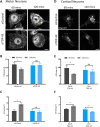TDP-43 regulation of stress granule dynamics in neurodegenerative disease-relevant cell types
- PMID: 29765078
- PMCID: PMC5953947
- DOI: 10.1038/s41598-018-25767-0
TDP-43 regulation of stress granule dynamics in neurodegenerative disease-relevant cell types
Abstract
Stress granules (SGs) are cytoplasmic foci that form in response to various external stimuli and are essential to cell survival following stress. SGs are studied in several diseases, including ALS and FTD, which involve the degeneration of motor and cortical neurons, respectively, and are now realized to be linked pathogenically by TDP-43, originally discovered as a component of ubiquitin-positive aggregates within patients' neurons and some glial cells. So far, studies to undercover the role of TDP-43 in SGs have used primarily transformed cell lines, and thus rely on the extrapolation of the mechanisms to cell types affected in ALS/FTD, potentially masking cell specific effects. Here, we investigate SG dynamics in primary motor and cortical neurons as well as astrocytes. Our data suggest a cell and stress specificity and demonstrate a requirement for TDP-43 for efficient SG dynamics. In addition, based on our in vitro approach, our data suggest that aging may be an important modifier of SG dynamics which could have relevance to the initiation and/or progression of age-related neurodegenerative diseases.
Conflict of interest statement
The authors declare no competing interests.
Figures







References
Publication types
MeSH terms
Substances
LinkOut - more resources
Full Text Sources
Other Literature Sources
Miscellaneous

